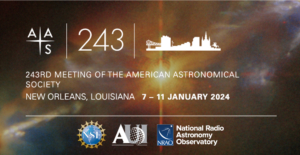A new study may help settle the question of how rapidly the Milky Way’s supermassive black hole is spinning.


COSMIC: SETI Institute Unlocks Mysteries of the Universe with Breakthrough Technology at the Very Large Array
In a groundbreaking cosmic quest, the SETI Institute’s Commensal Open-Source Multimode Interferometer Cluster (COSMIC) at the Karl G. Jansky Very Large Array (VLA) is expanding the search for extraterrestrial intelligence (SETI). This cutting-edge technology is not a distinct telescope; it’s a detector. COSMIC searches for extraterrestrial signals and paves the way for future science using a copy of the raw data from the telescope’s observations.

NRAO in the press at AAS 243
New scientific results from the Atacama Large Millimeter/submillimeter Array (ALMA), the Very Large Array (VLA), and Green Bank Observatory…

The People Behind the Very Large Array
Zach Gallegos is a shining example of dedication and hard work. His journey from a security guard to the HVAC and Plumbing lead at the VLA is inspiring. Despite the challenges, he continues to serve with grit and determination, ensuring the smooth operation of the VLA. His story serves as a reminder that with passion and dedication, one can achieve great heights in any field.

Book Release: “Joe Pawsey and the Founding of Australian Radio Astronomy”
This book was more than 15 years in the making, and it is a collaboration of three authors across two continents who worked together to bring to light the story of Joe Pawsey, a key figure in Australian science and, especially, radio astronomy.

VLA Finds Cosmic Rays Driving Galaxy’s Winds
VLA observations revealed that cosmic rays can play an important role in driving winds that rob galaxies of the gas needed to form new stars. This mechanism may be an important factor in galactic evolution, particularly at earlier times in the history of the universe.





